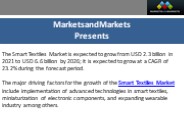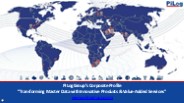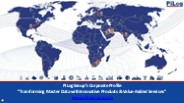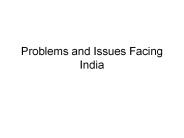Smart Textiles Market 2021 PowerPoint PPT Presentations
All Time
Recommended
Smart Textiles Market with COVID-19 impact analysis by Type (Passive, Active/Ultra-smart), Function (Sensing, Energy Harvesting & Thermo-electricity, Luminescence & Aesthetics), Vertical, & Geography - Global Forecast to 2026
| PowerPoint PPT presentation | free to download
Download free PDF Sample: https://bit.ly/3s1CGE0 #MilitarySmartTextiles #MarketAnalysis Military Smart Textiles market was valued at xx million in 2020 and is projected to reach US$ xx million by 2027, at a CAGR of xx% during the forecast period.
| PowerPoint PPT presentation | free to download
Looking forward, the smart textiles market value is projected to reach a strong growth during the forecast period (2021-2026). More info:- https://www.imarcgroup.com/smart-textiles-market
| PowerPoint PPT presentation | free to download
Market Research Future Publish New Market Research Report On-“Smart Textiles Market 2021 Global Analysis, Size, Share, Trends, Opportunities and Growth, Forecast 2027”
| PowerPoint PPT presentation | free to download
The Biomedical Textiles Market size is forecast to reach US$17.3 billion by 2027, after growing at a CAGR of 5.1% during the forecast period 2022-2027.
| PowerPoint PPT presentation | free to download
The Stretchable Electronics Market size is analyzed to grow at a CAGR of 25.3% during the forecast 2021-2026 to reach $2.98 billion by 2026
| PowerPoint PPT presentation | free to download
Avail more information from Sample Brochure of report @ https://goo.gl/FmWwcy A detailed qualitative analysis of the factors responsible for driving and restraining growth of the Global Smart Textile Industry Analysis & Forecast Report 2016-2021 Industry Market and future opportunities are provided in the report.
| PowerPoint PPT presentation | free to download
The conductive textiles market is expected to witness market growth at a rate of 16.05% in the forecast period of 2021 to 2028. Data Bridge Market Research report on conductive textiles market provides analysis and insights regarding the various factors expected to be prevalent throughout the forecast period
| PowerPoint PPT presentation | free to view
In order to add color and complexity to textiles, textile dyeing involves applying dyes to a textile material (fiber or fabric), thus increasing the value of the product.
| PowerPoint PPT presentation | free to download
The medical smart textile market is expected to gain market growth in the forecast period of 2021 to 2028. Data Bridge Market Research analyses the market to account to USD 2,115.66 million by 2028 and is expected grow at a CAGR of 6.33% in the above mentioned forecast period.
| PowerPoint PPT presentation | free to download
The Smart Polymer market is analysed and market size information is provided by regions (countries).
| PowerPoint PPT presentation | free to download
The Smart Textiles Market Size, Analysis, Trends, & Forecasts. The Global market for Smart Textiles categorized by Type, Function, Vertical, Size and Geography.
| PowerPoint PPT presentation | free to download
The report coverage includes various segmentations in the Functional Textile Finishing Agents Market and Market landscape along with Market Drivers and Challenges.
| PowerPoint PPT presentation | free to download
Nonwoven fabric market size is forecast to reach $42 billion by 2025, after growing at a CAGR of 7.4% during 2020-2025, owing to the wide usage of nonwoven fabrics in various applications such as agricultural coverings, apparel lining, automotive upholstery, carpeting, filters, disposable diapers, hygiene products, roofing, wall coverings and sterile medical products. The demand for nonwoven fabrics are increasing in varied industries due to its extensive set of properties such as absorbency, cushioning, retardancy, excellent thermal insulation, sterility, strength, softness and liquid repellency.
| PowerPoint PPT presentation | free to download
The global smart polymers market reached a value of US$ 1.37 Billion in 2021. Looking forward, IMARC Group expects the market to reach US$ 3.24 Billion by 2027, exhibiting at a CAGR of 15.3% during 2022-2027. More info:- https://www.imarcgroup.com/smart-polymers-market
| PowerPoint PPT presentation | free to download
The global graphene nanoplatelets market size reached US$ 57.1 Million in 2021. Looking forward, IMARC Group expects the market to reach US$ 383.5 Million by 2027, exhibiting a growth rate (CAGR) of 37.4% during 2022-2027. More info:- https://www.imarcgroup.com/graphene-nanoplatelets-market
| PowerPoint PPT presentation | free to download
Looking forward, the smart textiles market value is projected to reach a strong growth during the forecast period (2022-2027). More info:- https://www.imarcgroup.com/smart-textiles-market
| PowerPoint PPT presentation | free to download
Battery Material Recycling Market is likely to witness an impressive CAGR of 10.0% during the forecast period. Major factors such as growing automobile sector, escalating demand for smart devices and electronic gadgets and motor vehicle production, and high demand for Li-ion technology in electric vehicles are expected to fuel the growth of the battery material recycling market during the forecast period.
| PowerPoint PPT presentation | free to download
Thermochromic materials market is likely to witness an impressive CAGR of 9.2% during the forecast period. The growing demand for thermochromic materials is mainly due to their superior and efficient properties and their wide usage in various applications.
| PowerPoint PPT presentation | free to download
Microencapsulated Paraffin Phase Change Materials Market is projected to surpass USD 370 million by 2028.
| PowerPoint PPT presentation | free to download
The report analysis the global market of Smart Textile by main manufactures and geographic regions. The report includes Smart Textile definitions, product type, applications and industry chain structure, development trends, competitive landscape analysis, and key regions development and import/export status.
| PowerPoint PPT presentation | free to download
Smart textiles are the clothing materials that are embedded with electronic components such as sensors, monitors etc.
| PowerPoint PPT presentation | free to download
Market Size – USD 6.16 Billion in 2020, Market Growth – at a CAGR of 9.1%, Market Trends – Increasing demand for autonomous refueling systems
| PowerPoint PPT presentation | free to download
The textile manufacturing industry forms the very fabric of our daily lives, contributing to the global economy and shaping fashion trends. In this blog, we explore the intricate threads of the Apparel and Textile Market, shedding light on its major players, market analysis, growth rates, challenges, and future outlook.
| PowerPoint PPT presentation | free to download
Micro Battery Market with COVID-19 Impact Analysis by Type (Thin-film, Printed, Solid-state Chip, Button Battery), Capacity, Rechargeability, Application (Medical Devices, Consumer Electronics, Smart Packaging) and Geography - Global Forecast to 2026
| PowerPoint PPT presentation | free to download
The AI sensor market is projected to reach USD 22.1 billion by 2028, from USD 3.0 billion in 2022, at a CAGR of 41.6%. Factors such as the high installation and maintenance cost, lack of trust and awareness among end users, and complexity in data storage act as restraints for the growth of the market.
| PowerPoint PPT presentation | free to download
Advancements in bio-fabrication technology is a key factor driving market revenue growth
| PowerPoint PPT presentation | free to download
The increasing demand for polylactic acid (PLA) in the packaging sector is one of the significant factors influencing the market growth.
| PowerPoint PPT presentation | free to download
A new report on "Global Organic Phase Change Material Market Research Report - Industry Analysis, Size, Share, Growth, Trends and Forecast, 2014 - 2021” seen on DecisionDatabases.com analyses the complete market. Industry’s growth trends, forecasts, size and market share are analysed.
| PowerPoint PPT presentation | free to download
Retailing in Turkey, Market Shares, Summary & Forecasts to 2021", provides data for historic and forecast retail sales, and also includes information on the business environment and country risk related to Turkeyn retail environment
| PowerPoint PPT presentation | free to download
Industrial robots are a programmable mechanical device used in place of a human to perform the crucial or repetitive tasks with a high degree of accuracy. These consist of cables, intricate systems to the small parts, guarding, grippers, and components. Among various components, robotic flat cables play an important role as they transmit control and monitoring signals as well as power to desired systems/components.
| PowerPoint PPT presentation | free to download
Nonwoven fabric market size is forecast to reach $42 billion by 2025, after growing at a CAGR of 7.4% during 2020-2025, owing to the wide usage of nonwoven fabrics in various applications such as agricultural coverings, apparel lining, automotive upholstery, carpeting, filters, disposable diapers, hygiene products, roofing, wall coverings and sterile medical products. The demand for nonwoven fabrics are increasing in varied industries due to its extensive set of properties such as absorbency, cushioning, retardancy, excellent thermal insulation, sterility, strength, softness and liquid repellency. Nonwoven fabrics can be designed with specific targeted properties such as can be produced with substantial variations in thickness, mass, voluminosity, elasticity and stiffness. Also, nonwoven fabrics are comparatively quick and cheap to manufacture than the knitted fabrics, which is anticipated to drive the nonwoven fabric market substantially during the forecast period.
The apparel and textile industry market size is estimated at USD 748 billion in 2024. expected to grow at a compound annual growth rate of 3.52% during the forecast period from 2024 to 2029, reaching a market size of USD 889.24 billion by 2029.
| PowerPoint PPT presentation | free to download
Market Size – USD 10.68 Billion in 2021, Market Growth – at a CAGR of 5.9%, Market Trends – Growing emphasis on wastewater treatment and environmental improvements
| PowerPoint PPT presentation | free to download
The Micro Battery Market size is expected to reach USD 842 million by 2026 from USD 326 million in 2021, at a CAGR of 20.9%
| PowerPoint PPT presentation | free to download
The Global Wearable Solar Technology market size is forecast to reach $158 million by 2026, growing at a CAGR of 15.1% from 2021 to 2026.
| PowerPoint PPT presentation | free to download
The global reflective material market reached a value of US$ 6.1 Billion in 2021. Looking forward, IMARC Group expects the market to reach US$ 8.4 Billion by 2027, exhibiting a CAGR of 5.37% during 2022-2027. More info:- https://www.imarcgroup.com/reflective-material-market
| PowerPoint PPT presentation | free to download
Increasing application in end-use industries such as electrical & electronics is one of the significant factors influencing the market growth.
| PowerPoint PPT presentation | free to download
The increasing demand for polylactic acid (PLA) in the packaging sector is one of the significant factors influencing the market growth.
| PowerPoint PPT presentation | free to download
Increasing government initiatives to drive awareness regarding energy conservation and to encourage adoption of renewable power resources is the primary factor driving global virtual power plant market growth.
| PowerPoint PPT presentation | free to download
Prelims Test Series 2021 - 3500+ topics covered through smart solution. One of the best test series, exclusively for UPSC aspirants preparing for IAS prelims 2021.By GS Score
| PowerPoint PPT presentation | free to download
The global biodiesel market size reached USD 32.05 Billion in 2021 and is expected to register a revenue CAGR of 9.9% during the forecast period, according to latest analysis by Emergen Research. Growing demand for biodiesel from the automotive industry is the key factor driving revenue growth of the market. The need for eco-friendly fuel alternatives is growing, and biodiesel is currently gaining popularity. This is owing to the increased international volatility of crude oil prices as well as the negative environmental effects of fossil fuels.
| PowerPoint PPT presentation | free to download
FMI study offers a 5-year forecast for the global wearable computing devices market between 2015 and 2020. The market is expected to register a strong CAGR of 36.8% during the projected period. The study demonstrates the market dynamics and trends in all seven regions which influence the current nature and future status of wearable computing devices and accessories over the forecast period.
| PowerPoint PPT presentation | free to download
The global Operational Technology Market size was USD 145.60 Billion in 2021 and is expected to register a revenue CAGR of 6.5% during the forecast period, according to latest analysis by Emergen Research. Revenue growth in the operational technology market is driven by an increasing focus on real-time data analytics and predictive maintenance, strategic government initiatives to accelerate the adoption of operational technology, the development of machine learning and big data analytics, and rapid growth driven by emerging markets driven by factors such as strong industrial growth. Operational Technology (OT) refers to hardware and software used to directly monitor and/or control industrial machines, equipment, processes, and events to identify or implement changes.
| PowerPoint PPT presentation | free to download
The global frontline workers training market size is expected to reach USD 63.00 Billion at a steady revenue CAGR of 16.2% in 2030, according to latest analysis by Emergen Research. Rising demand for LMS to effectively manage learning content is a major factor driving market revenue growth. Frontline workers frequently work long hours and face additional challenges such as a shortage of resources and work-related uncertainty.
| PowerPoint PPT presentation | free to download
Firm demand for Stearic Acid from the polymer and textile industry has sustained its rich market sentiments in Europe. As European Union is eyeing to reduce the imports of palm oil as it leads to increased deforestation activities, concerns of stressed availability of the feedstock has provided a forward push to the prices of Stearic Acid in the regional market.
| PowerPoint PPT presentation | free to download
Butyl Acetate supply across the Europe remained tight throughout the fourth quarter after the major producer BASF declared force majeure at one of its upstream n-Butanol (NBA) facilities due to unspecified technical problems at its production unit in Ludwigshafen, Germany. Strong pull from the downstream markets and tight production levels spurred the regional offers during Q4, which are anticipated to extend further gains even in the upcoming quarter.
| PowerPoint PPT presentation | free to download
In the ever-evolving landscape of fashion, the global Apparel and Footwear Market is a dynamic force, with growth trends and forecasts painting a promising picture for the coming years. Let’s dive into the intricacies of this vibrant industry, exploring key market dynamics, major players, and recent developments that shape the future of apparel and footwear.
The Diethylene Glycol (DEG) Market registered demand of 3.25 million tonnes in 2020 and is projected to achieve a healthy CAGR of 5.12% in the forecast period until 2035.
Caustic Soda supplies remained balanced in the first quarter of 2021, as various Asian producers scheduled a maintenance turnaround, however the situation seemed to balance out as a key producer resumed its unit during the end of January.
The American Hydrogen peroxide market faced abrupt surge in its prices due to lack of proper availability of feedstock chemicals and monthly rise in natural gas value. The demand for hydrogen peroxide from the downstream textile and healthcare industry remained firm during this quarter.
Get a unified view of a PiLog company s risk footprint throughout the master data record manager application. PiLog enables you to standardize, analyze and mitigate operational risk.
| PowerPoint PPT presentation | free to download
Get a unified view of a PiLog company s risk footprint throughout the master data record manager application. PiLog enables you to standardize, analyze and mitigate operational risk.
| PowerPoint PPT presentation | free to download
Master Data Management (MDM) tools are essential for businesses that need to keep their critical data accurate, consistent, and reliable. These tools provide a centralized approach to managing key business information like customer details, product specifications, and financial data ensuring that everyone in the organization has access to a single, trustworthy version of the truth. One of the major advantages of MDM tools is their ability to break down data silos within an organization. Often, different departments use different systems to manage their data, leading to inconsistencies and miscommunications. MDM tools unify this data, making it easier to share information across departments and ensuring that everyone is on the same page. By providing a clear, consistent, and reliable view of key business information, MDM tools enable organizations to unlock the full potential of their data, driving growth, efficiency, and success.
| PowerPoint PPT presentation | free to download
The village is the focus of life for 74 percent of the Indian population with an estimated ... New Delhi, Gurgaon, and Hyderabad. U.S. companies in India IT ...
| PowerPoint PPT presentation | free to download
Ammonia production in North America remained disrupted throughout the quarter due to severe climate calamity. Supply for Ammonia across the region remained tight while the demand remained firm from downstream agrochemicals industries.
























































